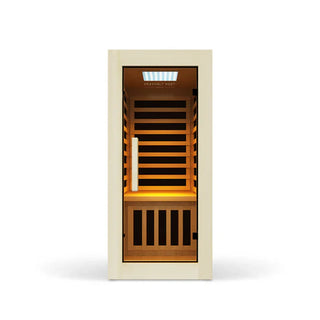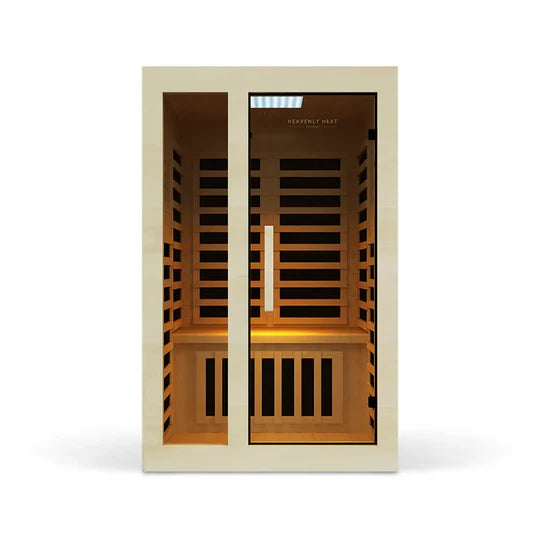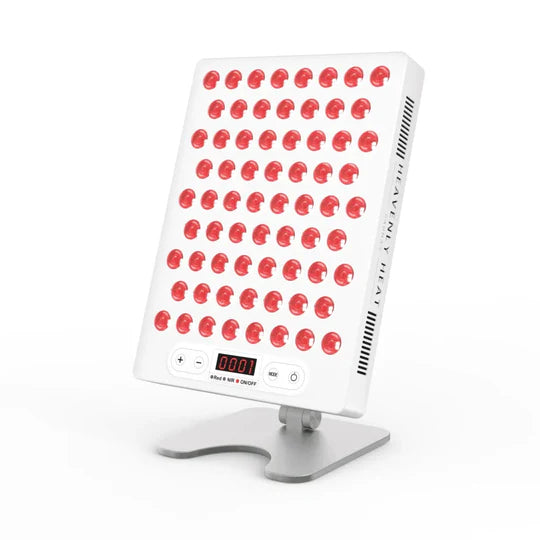How Much Does a Sauna Cost? (2024 Guide)

Saunas are a popular addition to many homes, offering relaxation and therapeutic benefits. But before investing in a sauna, it’s important to understand the costs involved. In this article, we will explore the various factors that contribute to the cost of a sauna, as well as provide tips on how to save money.
Average Sauna Cost
When it comes to saunas, the cost can vary significantly depending on several factors. These include the wood type, size, and sauna type. Let’s take a closer look at each of these factors:
Cost by wood type:
The type of wood used in constructing a sauna can greatly impact the cost. Common wood types include cedar, hemlock, and pine. Cedar, known for its durability and resistance to decay, tends to be the most expensive option. Hemlock, on the other hand, offers similar benefits at a lower cost. Pine is the most affordable option, but it may require more maintenance in the long run.
The choice of wood not only affects the cost but also contributes to the overall aesthetics of the sauna. Cedar, with its natural reddish hue and pleasant aroma, creates a luxurious and inviting atmosphere. Hemlock, with its light color and smooth texture, provides a more modern and clean look. Pine, although budget-friendly, can still exude a cozy and rustic charm when properly maintained and treated.
| Sauna Material | Starting Price Range |
| Cedar | $1,500 – $7,000 |
| Hemlock | $1,200 – $5,000 |
| Pine | $800 – $3,500 |
| Redwood | $2,000 – $8,000 |
| Basswood | $1,000 – $4,500 |
Cost by Size
The size of the sauna is another important consideration. Larger saunas generally come with a higher price tag due to the additional materials required for construction. It’s important to determine the appropriate size based on your needs and available space.
When choosing the size of your sauna, think about how many people will typically be using it at once. A larger sauna allows for more people to enjoy the experience together, making it ideal for social gatherings or family use. On the other hand, a smaller sauna may be more suitable for personal relaxation and can fit into tighter spaces, such as a small backyard or indoor room.
| Sauna Size | Dimensions (Square Feet) | Starting Price Range | Seating Capacity |
| Small | 4’x4′ to 5’x7′ | $500 – $2,500 | 1-2 people |
| Medium | 5’x7′ to 6’x8′ | $2,500 – $5,000 | 3-4 people |
| Large | 6’x8′ and above | $5,000 and above | 5 or more people |
Cost by Type
Saunas come in various types, including traditional saunas, infrared saunas, and steam saunas. Traditional saunas, which use heated rocks to generate steam, are typically the most expensive option. Infrared saunas, which use infrared lamps to heat the body directly, are generally more affordable. Steam saunas, which produce moist heat, can also vary in cost depending on the specific features.
Each type of sauna offers unique benefits and experiences. Traditional saunas are known for their high temperatures and deep sweating effects, promoting relaxation and detoxification. Infrared saunas, on the other hand, provide gentle heat that can penetrate the body more effectively, offering therapeutic benefits such as pain relief and improved circulation. Steam saunas create a humid environment that can be beneficial for respiratory health and skin hydration, providing a different kind of sauna experience.
| Sauna Type | Starting Price Range |
| Traditional | $1,000 – $10,000 |
| Infrared | $800 – $6,000 |
| Barrel | $3,000 – $12,000 |
| Outdoor | $2,000 – $15,000 |
| Portable | $200 – $5,000 |
| Steam | $2,500 – $15,000 |
Factors Affecting Cost
“The sauna slows down the aging process of the skin. It improves collagen and elastin production. It detoxifies the skin through the sweating process,” says Dr. Faryan Jalalabadi, a specialist in dermatology and skin health. When thinking about the cost of a sauna, it’s important to look at more than just the basic parts. Understanding these factors can help you make a smart decision when getting a sauna for your home or business.
Brand
The brand of the sauna can have a significant impact on the price. Well-known and established brands often come with a higher price tag due to their reputation for quality and durability. Additionally, premium brands may offer extended warranties and customer support, which can be beneficial in the long run.
Features
Saunas can come with a range of additional features, such as built-in audio systems, mood lighting, and aromatherapy options. These features not only enhance the overall sauna experience but also contribute to the cost of the sauna. Customizable features and advanced technologies can further elevate the price but can provide a luxurious and tailored sauna experience.
Maintenance
While saunas generally don’t require extensive maintenance, regular cleaning and occasional repairs are necessary to ensure optimal performance and longevity. The cost of maintenance, including cleaning supplies, replacement parts, and professional servicing, should be factored into the overall cost of owning a sauna. Investing in high-quality materials and proper maintenance can prolong the lifespan of your sauna.
Electricity Use
It’s important to consider the ongoing electricity costs associated with operating a sauna. Saunas can be energy-intensive, particularly traditional saunas and steam saunas. Opting for energy-efficient models, such as infrared saunas or hybrid saunas, can help reduce these costs in the long run. Additionally, exploring renewable energy sources or off-peak electricity usage can further lower your sauna’s operational expenses.
Professional vs. DIY sauna installation cost
You can either hire a professional or do it yourself when installing a sauna. Hiring a pro usually costs more upfront, but it ensures a correct job and may include a warranty. On the other hand, if you have the skills and are comfortable with DIY, installing the sauna yourself can save money, but be prepared for more time and effort.
Hidden Costs of DIY Sauna Installation
Building a DIY sauna might seem like a budget-friendly choice, but hidden costs can quickly add up. One major expense is electrical and heating elements, which can cost anywhere from $500 to $3,000, depending on the type of heater. If you don’t have electrical experience, hiring an electrician can add another $500 to $2,000. Permits are another hidden cost—many areas require them, costing anywhere from $50 to $500. Mistakes in DIY projects are common, and fixing them can cost hundreds or even thousands. Plus, DIY saunas often require more maintenance over time, making professional installation a smarter long-term choice.
Signs That You Need To Repair a Sauna
Over time, saunas may require repairs to maintain their functionality and safety. Here are some signs that indicate the need for repairs:
Inconsistent Temperature
If you notice that your sauna is not reaching or maintaining the desired temperature, it could be a sign of a faulty heating element or thermostat. Repairs or replacements may be necessary to restore optimal sauna conditions.
Visible Damage to Wood
Inspect the interior and exterior of your sauna for any visible damage to the wood, such as cracks, warping, or discoloration. These issues can compromise the sauna’s structural integrity and should be addressed promptly.
Bad smelling
A strong odor emanating from the sauna can indicate mold or mildew growth, which can be harmful to your health. Proper cleaning and maintenance, or professional assistance, may be required to eliminate the odor and address the underlying issue.
How To Save on Sauna Costs
There are many ways to keep your sauna costs low. Here are some ideas to save money.
Compare Prices
When shopping for a sauna, compare prices from various retailers and manufacturers to find the best deal and potentially save money.
Look for Discounts and Sales
Keep an eye out for discounts, promotions, and sales events. Many retailers offer seasonal deals or special offers that can help you save on the cost of a sauna.
Buy a smaller Sauna
Consider your needs and available space when choosing the sauna size. Opting for a smaller sauna can significantly reduce the cost while still providing a relaxing experience.
Choose Energy-Efficient Models
Energy-efficient saunas can help reduce the operating costs associated with running a sauna. Look for models with energy-saving features and high insulation ratings to minimize electricity consumption.
You can buy a used sauna
If buying new isn’t a priority, consider purchasing a used sauna. Many people sell their saunas at a discounted price, allowing them to save money while still enjoying the benefits of owning a sauna.
Saving Money with Off-Season Purchases
Buying a sauna during the off-season is the best way to save big. Prices drop in late winter and early spring when demand is low, making it the perfect time to buy. Discounts can range from 10% to 30%, and some retailers even offer free installation or accessories. Manufacturers also clear out older models around February and March, so you can find great deals. Local stores may have better discounts than online retailers since they need to make room for new stock. To find the best deals, check clearance sales, compare prices, and ask about seasonal promotions.
Long-Term Savings Through Proper Maintenance
Regular sauna maintenance keeps costs low and prevents expensive repairs. Ignoring small issues, like worn-out seals or dirty heaters, can lead to major breakdowns that cost a fortune. The most cost-effective way to maintain a sauna is by cleaning it regularly, checking for moisture damage, and ensuring proper ventilation. Energy efficiency also plays a big role—using a timer, upgrading insulation, and maintaining heating elements can significantly cut electricity costs. Many people make the mistake of delaying maintenance, which leads to costly fixes later. Instead of replacing sauna benches, refurbishing them can extend their life at a fraction of the cost.
What are the pros and cons of owning a sauna?
Owning a sauna has its benefits and drawbacks. Let’s take a closer look at the pros and cons:
Pros
- Relaxation and stress relief
- Promotes muscle relaxation and pain relief
- Improved blood circulation
- Detoxification through sweating
- Potential immune system boost
Cons
- High initial cost
- Maintenance requirements
- Energy consumption
- Potential health risks for certain individuals
FAQs About Sauna Costs
Is it expensive to maintain a sauna?
The cost of maintaining a sauna can vary depending on factors such as the type of sauna, frequency of use, and any necessary repairs. While there are ongoing expenses associated with owning a sauna, such as electricity and cleaning supplies, they are generally manageable. Performing regular maintenance and addressing any issues promptly can help minimize long-term costs.
Why are saunas so expensive?
Saunas are generally considered a luxury home addition, which can contribute to their higher price tag. The cost of materials, construction, and specialized equipment all add to the overall expense. Additionally, well-established brands often command higher prices due to their reputation for quality and reliability.
How Long Do Saunas Last?
The lifespan of a sauna can vary depending on several factors, including the quality of materials, construction, and ongoing maintenance. With proper care and maintenance, a well-built sauna can last for decades, providing you with years of relaxation and enjoyment.


























